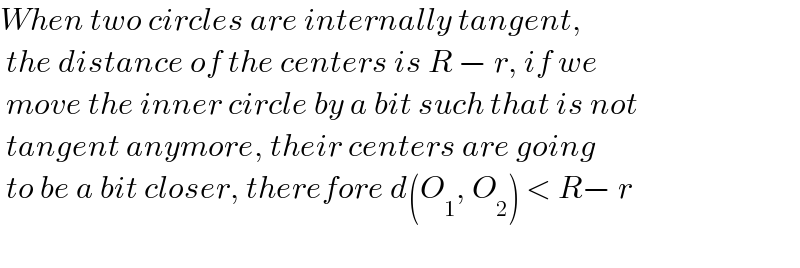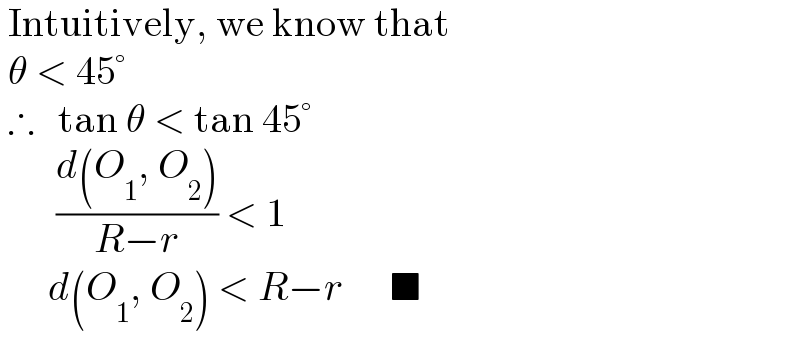
Question Number 185111 by emmanuelson123 last updated on 17/Jan/23

Commented by Eulerian last updated on 17/Jan/23

$$\mathrm{what}\:\mathrm{does}\:{d}\left({O}_{\mathrm{1}} ,\:{O}_{\mathrm{2}} \right)\:\mathrm{means}? \\ $$
Commented by JDamian last updated on 17/Jan/23
that means the "distance between O1 and O2"
Commented by emmanuelson123 last updated on 17/Jan/23
It means the distance between the centers of the circle
Answered by HeferH last updated on 17/Jan/23

Commented by HeferH last updated on 17/Jan/23

$${When}\:{two}\:{circles}\:{are}\:{internally}\:{tangent},\: \\ $$$$\:{the}\:{distance}\:{of}\:{the}\:{centers}\:{is}\:{R}\:−\:{r},\:{if}\:{we}\: \\ $$$$\:{move}\:{the}\:{inner}\:{circle}\:{by}\:{a}\:{bit}\:{such}\:{that}\:{is}\:{not} \\ $$$$\:{tangent}\:{anymore},\:{their}\:{centers}\:{are}\:{going} \\ $$$$\:{to}\:{be}\:{a}\:{bit}\:{closer},\:{therefore}\:{d}\left({O}_{\mathrm{1}} ,\:{O}_{\mathrm{2}} \right)\:<\:{R}−\:{r} \\ $$$$\: \\ $$
Commented by mr W last updated on 20/Jan/23

$${the}\:{incircle}\:{and}\:{the}\:{circumcircle}\:{of} \\ $$$${a}\:{triangle}\:{can}\:{never}\:{touch}\:{each}\:{other}. \\ $$
Commented by HeferH last updated on 20/Jan/23

$$\:? \\ $$
Commented by mr W last updated on 20/Jan/23

Answered by Eulerian last updated on 17/Jan/23

Commented by Eulerian last updated on 17/Jan/23

$$\:\mathrm{Intuitively},\:\mathrm{we}\:\mathrm{know}\:\mathrm{that} \\ $$$$\:\theta\:<\:\mathrm{45}° \\ $$$$\:\therefore\:\:\:\mathrm{tan}\:\theta\:<\:\mathrm{tan}\:\mathrm{45}° \\ $$$$\:\:\:\:\:\:\:\frac{{d}\left({O}_{\mathrm{1}} ,\:{O}_{\mathrm{2}} \right)}{{R}−{r}}\:<\:\mathrm{1} \\ $$$$\:\:\:\:\:\:{d}\left({O}_{\mathrm{1}} ,\:{O}_{\mathrm{2}} \right)\:<\:{R}−{r}\:\:\:\:\:\:\blacksquare \\ $$
Answered by mr W last updated on 20/Jan/23

$${euler}'{s}\:{theorem}: \\ $$$${d}^{\mathrm{2}} ={R}^{\mathrm{2}} −\mathrm{2}{Rr} \\ $$$${d}^{\mathrm{2}} <{R}^{\mathrm{2}} −\mathrm{2}{Rr}+{r}^{\mathrm{2}} =\left({R}−{r}\right)^{\mathrm{2}} \\ $$$$\Rightarrow{d}<{R}−{r} \\ $$
